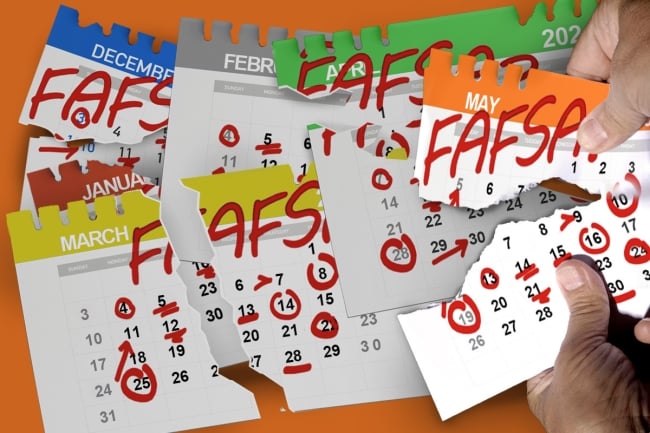You have /5 articles left.
Sign up for a free account or log in.

Student aid forms are finally being sent, but the slow pace and technical problems could further hamper an already troubled admissions cycle.
Photo illustration by Justin Morrison/Inside Higher Ed | Getty Images
The Department of Education on Tuesday announced yet another delay in this year’s much-criticized rollout of the new Free Application for Federal Student Aid form, indicating that colleges will not begin receiving applicants’ federal aid information until March at the earliest.
In a press conference Tuesday morning, education under secretary James Kvaal said the department plans to begin sending students’ FAFSA information, contained in Institutional Student Information Records (ISIR), to colleges “in batches in the first half of March”—nearly two months later than the late-January timeline the department indicated when the FAFSA soft launched at the end of 2023.
Kvaal declined to specify an exact date or guarantee that colleges would receive the forms by March. That has many worried that, after months of mercurially shifting timelines, colleges may not receive students’ records until closer to April or even May. Such a shift is certain to give applicants a much narrower window in which to weigh their college-going options.
“I am stunned. Gobsmacked, really,” said Angel Pérez, president of the National Association for College Admission Counseling. “This is devastating—I’m not sure what other word to use—for the students the FAFSA is supposed to help and for institutions that have been waiting for this information.”
The delay is the latest hiccup in the rollout of the new FAFSA form, which was overhauled last year by congressional mandate in order to “simplify” the process and expand Pell eligibility—and which has been plagued by delays and uncertainty since the launch date was pushed to the end of last year.
Moving the ISIR submission date back is likely the most consequential and destructive of the setbacks, especially for low-income and first-generation applicants who depend on timely financial aid offers to make college decisions.
“For many students who are taking a real leap by even applying to college, uncertainty is as big a factor as the actual dollar amount in aid,” said Jon Fansmith, senior vice president for government relations at the American Council on Education. “That’s the whole reason we moved the deadline to October [in 2016] … The more uncertainty there is, and the shorter the decision window, the less likely they are to enroll.”
Institutions’ schedules for sending acceptance and financial aid offers are also likely to be disrupted.
“With this last-minute news, our nation’s colleges are once again left scrambling as they determine how best to work within these new timelines to issue aid offers as soon as possible,” Justin Draeger, president of the National Association of Student Financial Aid Administrators, wrote in a statement. “These continued delays, communicated at the last minute, threaten to harm the very students and families that federal student aid is intended to help.”
Universities may be forced to push their usual May 1 student commitment deadlines back to June or even July. Pérez said that while discussions with NACAC member institutions were ongoing, he “can’t imagine” maintaining the traditional May 1 deadline under these circumstances.
A number of recent errors appear to have contributed to the latest delay, chief among them a calculation oversight that did not account for inflation in the new Student Aid Index. In the press conference, Kvaal also announced that the department “will be updating” the SAI formulas to fix this error, and an Education Department spokesperson acknowledged that updating the tables for inflation was “a factor in the new timeline.”
‘A Nexus of Chaos’
Responding to a series of increasingly exasperated questions from the press pool Tuesday, a department spokesperson said they were “very aware of the calendar” and asked for patience.
But the patience of most higher education officials has long since run thin. Mark Kantrowitz, a financial aid expert and consultant, called the March delay the final thread in a “nexus of chaos” that is sure to be “a major disruption” to institutional planning. In an email to Inside Higher Ed that he also posted on LinkedIn, W. Kent Barnds, vice president for enrollment at Augustana College, said the department “should be ashamed of this failure.”
“This will be the latest that I’ve been able to award aid to college-bound students in the 32 years that I have been doing enrollment work,” he wrote. “I thought this was supposed to make things better.”
Sara Miller, executive director of Green Halo Scholars, a college counseling and financial guidance organization serving low-income and first-gen students around Chicago, said the department’s “smorgasbord of errors” around the FAFSA launch—including a recent technical glitch that prevents undocumented parents from filling out the form, which an ED spokesperson said they are still “working hard to address”—has made it difficult to celebrate what was supposed to be a major victory for college access. After all, she said, what good is expanding Pell eligibility if students won’t receive their financial aid offers until it’s practically too late?
“It feels like we’re taking one step forward to take 10 steps back,” she said. “It’s hard to point at this and tell my students, ‘It’s all going to be worth it.’”
It’s not just admission and financial aid offices that will be affected; without accurate data on enrollment and tuition revenue, entire university budgets and planning models could be thrown into uncertainty until midsummer.
“Colleges and universities build entire budgets based on the first-year class,” Pérez said. “All the decisions that allow a university to churn will be stalled.”
A spokesperson for the department declined to answer questions about how the rollout could affect future admission cycles. But Fansmith said he anticipates the consequences of this particular delay will echo into the fall and even next year.
“This is not a one-year problem at this point, where we just have to get through a tough cycle and then everything will be fine,” he said. “There are tails to this.”
Few Clear Answers, ‘No Clean Hands’
The ISIR delay has also added to political pressure for increased scrutiny of the department over its handling of the rollout, which has been building for months; just last week Republican lawmakers asked the Government Accountability Office to investigate the new FAFSA launch.
A few hours after the latest delay was announced, Republican representatives Virginia Foxx, co-chair of the House Committee on Education and the Workforce, and Burgess Owens, co-chair of the Subcommittee on Higher Education, sent a letter to Education Secretary Miguel Cardona criticizing the FAFSA’s “failure to launch.” The letter, shared with Inside Higher Ed, blames the rocky launch partially on Cardona’s focus on student debt relief and demands the department provide Congress with internal information and communications on its FAFSA rollout plan by Feb. 13—suggesting the possibility of a congressional hearing.
An ED spokesperson, meanwhile, laid the blame squarely at lawmakers’ feet, saying the department was given an unrealistic timeline for the overhaul and was denied additional resources to commit to the project.
“We are working under very substantial workload demands created by Congress, without the additional resources we request to meet them,” he said at the press conference.
That excuse does not satisfy many of the most vocal critics of the department’s handling of the launch. Dr. Bill Cassidy, a Republican senator from Louisiana and ranking member on the Senate education committee, excoriated the department for its continued delays and called the rollout “a disaster.”
“The Department of Education had three years to prepare the rollout of the updated FAFSA,” he wrote in a statement following ED’s announcement. “Their inability to do their job has real consequences for students and families.”
Even the department’s erstwhile defenders are at the ends of their ropes.
“I don’t know that anyone has clean hands here, but the department has really disappointed,” Fansmith said. “I understand that this overhaul has been a huge undertaking and that they are putting forth their best effort. But their best efforts, frankly, have been insufficient.”





